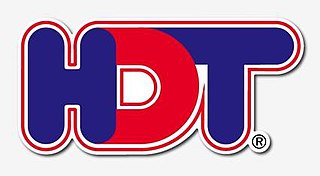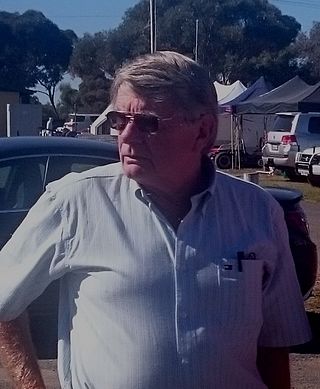
The Holden Dealer Team (HDT) was Holden's semi-official racing team from 1969 until 1986, primarily contesting Australian Touring Car events but also rallying, rallycross and Sports Sedan races during the 1970s. From 1980 the Holden Dealer Team, by then under the ownership of Peter Brock, diversified into producing modified road-going Commodores and other Holden cars for selected dealers via HDT Special Vehicles.

Colin John Bond is an Australian former racing driver. Bond reached the highest levels in Australian motorsport in 1969 when he was recruited by Harry Firth to the newly formed Holden Dealer Team. He quickly found success, winning the 1969 Hardie-Ferodo 500 mile race at Bathurst, New South Wales in a Holden Monaro.
Allan George MoffatOBE is a Canadian-born Australian racing driver known for his four championships in the Australian Touring Car Championship, six wins in the Sandown 500 and his four wins in the Bathurst 500/1000. Moffat was inducted into the V8 Supercars Hall of Fame in 1999.

Allan Maxwell Grice, known to motor-racing fans as "Gricey", is an Australian former racing driver and politician, most famous for twice winning the prestigious Bathurst 1000, and as a privateer driver of a Holden in the Australian Touring Car Championship.
The 1987 Australian Touring Car Championship was a motor racing competition which was open to Touring Cars complying with regulations as defined by the Confederation of Australian Motor Sport and based on FIA Group A rules. The championship, which was the 28th Australian Touring Car Championship, began on 1 March 1987 at Calder Park Raceway and ended on 5 July at Oran Park Raceway after nine rounds. The Calder round saw the world debut of the racing versions of the BMW M3, the Ford Sierra RS Cosworth and the Alfa Romeo 75 Turbo.
Robert Morris is an Australian former racing driver. Morris was one of the leading touring car drivers during the 1970s and continued racing until 1984. Morris won Australia's premier Touring car race, the Bathurst 1000 in 1976. He also won the Australian Touring Car Championship in 1979. Morris was inducted into the V8 Supercars Hall of Fame in 2004.

The 1982 James Hardie 1000 was the 23rd running of the Bathurst 1000 touring car race. It was held on 3 October 1982 at the Mount Panorama Circuit just outside Bathurst in New South Wales, Australia. The race, which was Round 3 of both the 1982 Australian Endurance Championship and the 1982 Australian Endurance Championship of Makes, was open to cars eligible to the locally developed CAMS Group C touring car regulations with two engine capacity based classes.

The 1980 Hardie-Ferodo 1000 was the 21st running of the Bathurst 1000 touring car race. It was held on 5 October 1980 at the Mount Panorama Circuit just outside Bathurst in New South Wales, Australia. The race was open to cars eligible under the locally developed CAMS Group C Touring Car regulations with four engine capacity based classes.

The 1979 Hardie-Ferodo 1000 was the 20th running of the Bathurst 1000 touring car race. It was held on 30 September 1979, at the Mount Panorama Circuit just outside Bathurst. The race was open to cars eligible to the locally developed CAMS Group C touring car regulations with four engine capacity based classes.

The 1978 Hardie-Ferodo 1000 was the 19th running of the Bathurst 1000 touring car race. It was held on 1 October 1978, at the Mount Panorama Circuit just outside Bathurst. The race was open to cars eligible to the locally developed CAMS Group C touring car regulations with three engine capacity based classes.
John Francis Harvey was an Australian racing driver. He was a top Speedcar driver for many years in the 1950s and 1960s, winning many championship races including the NSW Championship for three successive years and the Victorian Championship twice before turning his skills to road racing where he had a long and successful career until his retirement at the end of 1988. In 1987 John made history driving the General Motors Sunraycer to victory in the inaugural World Solar Challenge from Darwin to Adelaide, the first international race for purely solar powered cars.
The 1988 Australian Touring Car Championship was a CAMS sanctioned motor racing title for drivers of Group 3A Touring Cars. It was the 29th running of the Australian Touring Car Championship. The championship began on 6 March at Calder Park Raceway and ended on 17 July at Oran Park Raceway after nine rounds.
The 1986 Australian Touring Car Championship was an Australian motor racing competition for Touring Cars. It began on 2 March 1986 at Amaroo Park and ended on 13 July at Oran Park Raceway after ten rounds. The championship was authorised by the Confederation of Australian Motor Sport (CAMS) as an Australian National Title. It was the 27th Australian Touring Car Championship and the second to be contested by cars conforming with CAMS regulations based on the FIA's international Group A Touring Car regulations.
David John "Skippy" Parsons, is a retired Australian racing driver, who, while never a full-time racing driver, drove for some of the leading racing teams in Australia including the Holden Dealer Team, Perkins Engineering, Glenn Seton Racing and Gibson Motorsport.
The 1984 Australian Touring Car Championship was a motor racing competition for Group C Touring Cars. The Championship was authorised by the Confederation of Australian Motor Sport as an Australian National Title. It was the 25th Australian Touring Car Championship, and the last to be contested by Group C cars as new regulations, based on international Group A, were introduced for 1985.
The 1982 Australian Touring Car Championship was a CAMS sanctioned Australian motor racing title open to Group C Touring Cars. It began on 18 February 1982 at Sandown Raceway and ended on 16 May at Oran Park Raceway after eight rounds. The title, which was the 23rd Australian Touring Car Championship, was won by defending champion Dick Johnson, driving a Ford XD Falcon.

The 1983 Australian Touring Car Championship was a CAMS sanctioned motor racing title for drivers of Group C Touring Cars. The title, which was the 24th Australian Touring Car Championship, was contested over a series which began on 6 February 1983 at Calder Park Raceway and ended on 19 June at Lakeside International Raceway after eight rounds.
The 1972 Australian Touring Car Championship was a CAMS sanctioned national motor racing title open to Group C Improved Production Touring Cars and Group E Series Production Touring Cars. The championship, which was the 13th running of the Australian Touring Car Championship, began at Symmons Plains and ended at Oran Park after eight rounds.
The 1986 Australian Touring Car season was the 27th season of touring car racing in Australia commencing from 1960 when the first Australian Touring Car Championship and the first Armstrong 500 were contested. It was the second season in which Australian Touring Car regulations were based on those for the FIA Group A Touring Car category.
AMSCAR was a touring car series held in Australia between 1979 and 1997, based at Amaroo Park in Sydney.





